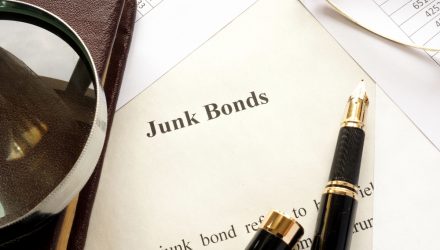Last week, the Federal Reserve unveiled its fifth interest rate hike of 2022, and with more on the way, it’s not surprising that fixed income exchange traded funds of nearly all varieties are faltering.
Junk bonds are certainly part of that dubious mix. The widely followed Markit iBoxx USD Liquid High Yield Index is down 13.04% year-to-date, and that decline has the index’s 30-day SEC yield sitting at a staggering 7.77%. Bond yields rise as prices decline.
Still, some market observers believe it could be time for investors to at least glance at high yield corporate debt and the relevant ETFs. If there’s merit in that recommendation, it could be a positive for the VanEck Fallen Angel High Yield Bond ETF (NASDAQ: ANGL).
“Better known as junk, the $1.5 trillion sector looks appealing, as yields have risen to an average of 8.8% from 4.4% at the start of 2022, according to the ICE BofA US High Yield Index. Junk debt offers an alternative—or supplement—to stocks,” reported Andrew Bary for Barron’s. “Better known as junk, the $1.5 trillion sector looks appealing, as yields have risen to an average of 8.8% from 4.4% at the start of 2022, according to the ICE BofA US High Yield Index. Junk debt offers an alternative—or supplement—to stocks.”
ANGL, which follows the ICE US Fallen Angel High Yield 10% Constrained Index, sports a 30-day SEC yield of 6.79%. While that’s high by recent standards for fallen angel bonds, it’s worth noting that the higher a bond’s yield is when an investor buys, the better the odds are of long-term success.
As for why ANGL’s yield is lower than that of standard high yield bond strategies, fallen angels aren’t standard junk bonds. They’re born with investment-grade ratings and are later downgraded to junk territory, meaning these high yield bonds have superior quality traits relative to their born-as-junk rivals.
That’s something to consider when some market participants are fretting about a recession while others believe there’s value in the high yield debt space. ANGL’s superior quality profile and tolerable default rates in the broader high yield space could be buffers if a recession comes to pass.
“The yield gap between junk debt and risk-free Treasuries has widened to five percentage points from three points at the start of 2022, based on the ICE index. Now, it would take a default rate of 8%, coupled with a bond recovery rate of just 40%, to effectively match the yield on Treasuries (8% times a loss rate of 60% is nearly 5%, the current spread of junk to Treasuries). The market overall appears to be in good shape, with the default rate running below 1%, although likely to head higher,” according to Barron’s.
For more news, information, and strategy, visit the Beyond Basic Beta Channel.
The opinions and forecasts expressed herein are solely those of Tom Lydon, and may not actually come to pass. Information on this site should not be used or construed as an offer to sell, a solicitation of an offer to buy, or a recommendation for any product.







